Drilling a Hole in a Tree Stump: A Step-by-Step Guide

Drilling a hole in a tree stump may seem like an unusual task, but it can be a necessary step in various situations. Whether you’re trying to remove a tree stump, create a natural planter, or decorate the stump for artistic purposes, drilling a hole can be a practical and effective solution.
In this step-by-step guide, we will walk you through the process of drilling a hole in a tree stump.
Step 1: Gather the necessary tools
Before you begin, make sure you have all the tools you’ll need for the job. This includes a drill with an appropriate drill bit for wood, safety goggles, gloves, and a measuring tape.
Step 2: Prepare the tree stump
Clear away any debris or loose bark from the surface of the tree stump. This will ensure a clean and smooth drilling surface.
Step 3: Determine the drilling depth and location
Decide how deep you want the hole to be and mark the desired depth on the drill bit with a piece of tape. Then, choose the location on the tree stump where you want to drill the hole.
Step 4: Start drilling
Put on your safety goggles and gloves, and position the drill bit on the marked location. Apply steady pressure and start drilling into the tree stump. Keep the drill bit straight and perpendicular to the surface of the stump.
Step 5: Remove the drill bit and debris
Once you’ve drilled the hole to the desired depth, slowly pull the drill bit out of the tree stump. Make sure to remove any wood chips or debris from the hole.
By following these steps, you can successfully drill a hole in a tree stump for various purposes. Remember to always prioritize safety and take necessary precautions while performing any task involving power tools.
Why and When You Should Drill a Hole in a Tree Stump
If you have recently cut down a tree in your yard or garden, you may be left with an unsightly stump as a reminder of the tree that once stood there. Removing a tree stump can be a difficult and time-consuming task, but drilling holes in the stump can make the process easier. Here are a few reasons why and when you should consider drilling holes in a tree stump:
1. Accelerating the decomposition process
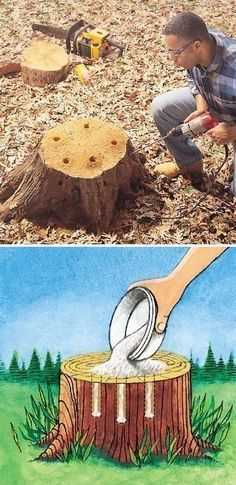
Drilling holes in a tree stump can help speed up the process of decomposition. When a tree stump starts to decompose naturally, it can take several years for it to completely break down. However, drilling holes in the stump and filling them with a nitrogen-rich substance such as fertilizer can provide the necessary nutrients to attract decomposing organisms. This can help break down the wood more quickly and effectively.
2. Making the stump easier to remove
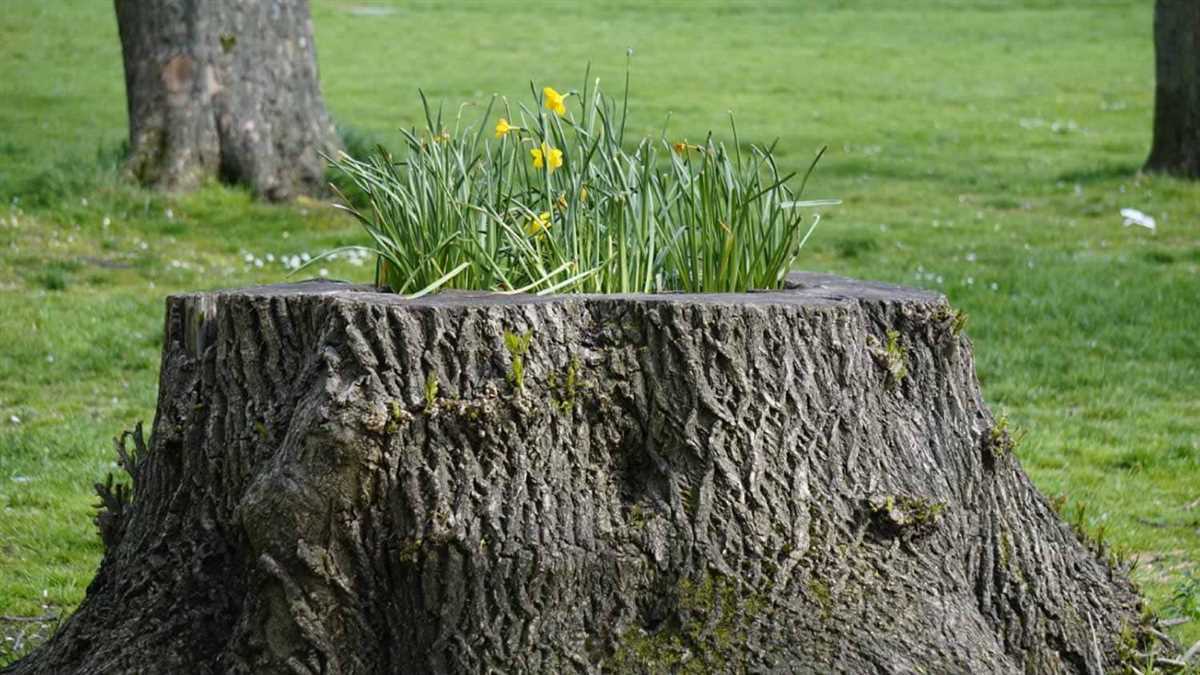
Drilling holes in a tree stump can also make it easier to remove. By creating holes around the perimeter of the stump, you can weaken the wood and make it more susceptible to breaking apart. This can then make it easier to remove the stump using a shovel, an axe, or even a stump grinder.
3. Preventing new tree growth
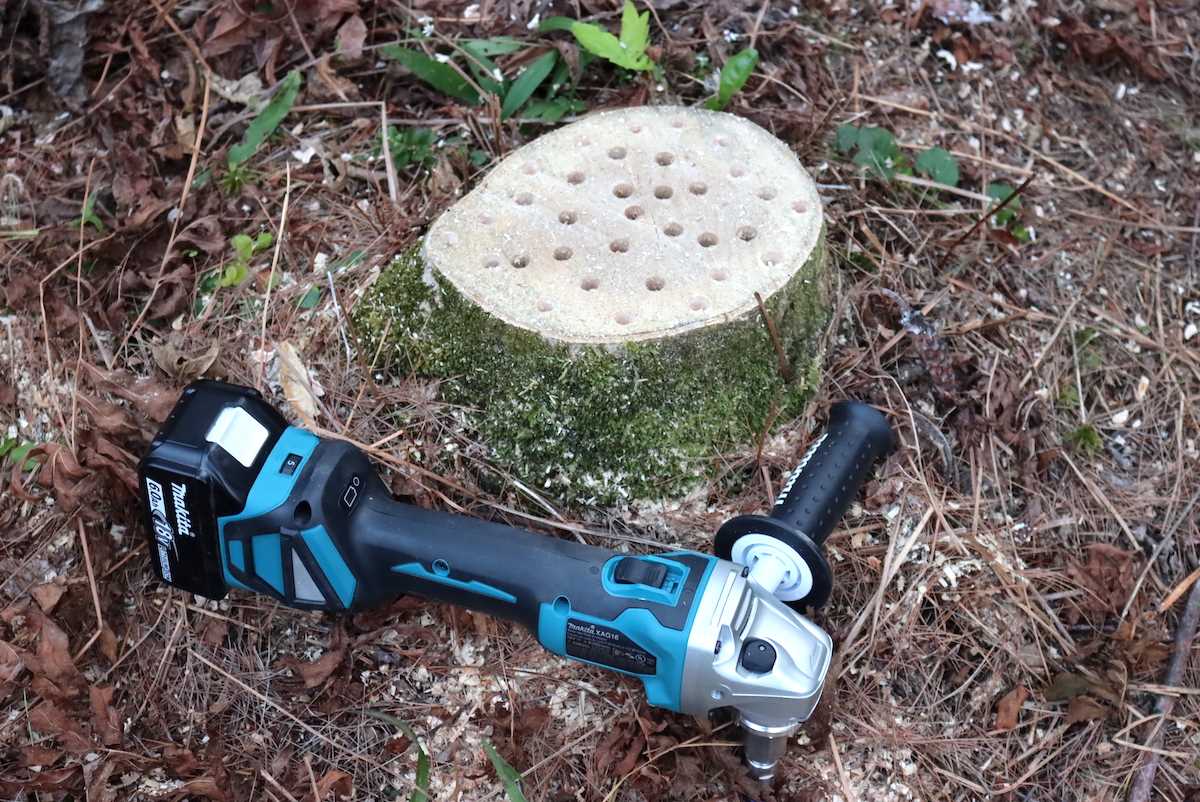
If you have cut down a tree but want to prevent new growth from sprouting out of the stump, drilling holes can be an effective solution. By drilling holes and filling them with an herbicide, you can kill the remaining roots and prevent any regrowth. This can save you from having to constantly remove new shoots that sprout from the stump.
Overall, drilling holes in a tree stump can be a useful technique for speeding up decomposition, making the stump easier to remove, and preventing new tree growth. However, it is important to note that drilling holes in a tree stump should be done carefully and safely to avoid injury. If you are unsure about how to properly drill holes in a stump, it is recommended to consult a professional for assistance.
The Benefits of Drilling a Hole in a Tree Stump
1. Promotes Decomposition
Drilling a hole in a tree stump can help speed up the natural decomposition process. When a tree is cut down, the stump will eventually decay on its own, but this can take many years. By drilling holes in the stump, you create openings for fungi and bacteria to enter, which will accelerate the decomposition process. This is especially beneficial if you want to remove the stump quickly or if the stump is causing an obstruction in your yard.
2. Prevents Regrowth
When a tree stump is left untreated, there is a chance that new shoots will sprout from the stump or the tree’s root system. These new shoots can be a nuisance, as they can grow into new trees or shrubs, causing further obstructions or damage to your property. By drilling holes in the stump and applying the appropriate chemicals or herbicides, you can prevent regrowth and ensure that the stump remains dormant.
3. Improves Aesthetic Appeal
A tree stump can be an eyesore in an otherwise well-maintained yard. By drilling holes in the stump, you can create openings for planting flowers, herbs, or other decorative plants. This can transform the stump from an unsightly feature into a unique and attractive garden element. Additionally, you can cover the stump with soil and use it as a base for a potted plant or create a small raised garden bed on top of it.
4. Provides a Home for Wildlife
A tree stump with drilled holes can attract various forms of wildlife, such as insects, birds, and small mammals. These creatures can use the holes as shelter, nesting sites, or as a source of food. This can enhance biodiversity in your yard and provide a habitat for beneficial insects, pollinators, and other wildlife species. Creating a wildlife-friendly environment is not only beneficial for the ecosystem but can also be a joy to observe and appreciate.
5. Utilizes the Stump’s Resources
Drilling holes in a tree stump allows you to make use of its resources. For example, you can drill holes and fill them with soil and compost to create a mini-garden. The decaying wood of the stump can also be used as mulch or a natural fertilizer for surrounding plants and trees. By utilizing the stump in this way, you can maximize the benefits of the tree that was once there and minimize waste.
In conclusion, drilling holes in a tree stump offers several benefits, including promoting decomposition, preventing regrowth, improving aesthetic appeal, providing a home for wildlife, and utilizing the stump’s resources. Whether you choose to remove the stump or repurpose it, drilling holes can help you make the most out of this remnant of a once-grand tree.
When to Drill a Hole in a Tree Stump
Drilling a hole in a tree stump can serve several purposes and can be done at different stages depending on the desired outcome. Here are a few situations when drilling a hole in a tree stump may be necessary:
1. Removing the Stump
Drilling holes in a tree stump can help facilitate the removal process. By creating holes in strategic locations, it becomes easier to break down the stump or accelerate the decomposition process. This method is especially useful when planning to remove the stump through chemical means or using stump removal products.
2. Tree Stump Art
If you have a creative spirit and enjoy woodwork, drilling holes in a tree stump can serve as a canvas for your artistic endeavors. By creating holes of different sizes and depths, you can transform a plain stump into a unique art piece. These holes can be filled with various materials, such as colored glass, marbles, or even flowers.
3. Enhancing Decomposition
When a tree stump is left to naturally decompose, it can take several years for it to fully break down. By drilling holes into the stump, you allow for better airflow and increased access for decomposers like insects and fungi. This helps speed up the decomposition process and reduces the time it takes for the stump to fully disappear.
4. Preventing Regrowth
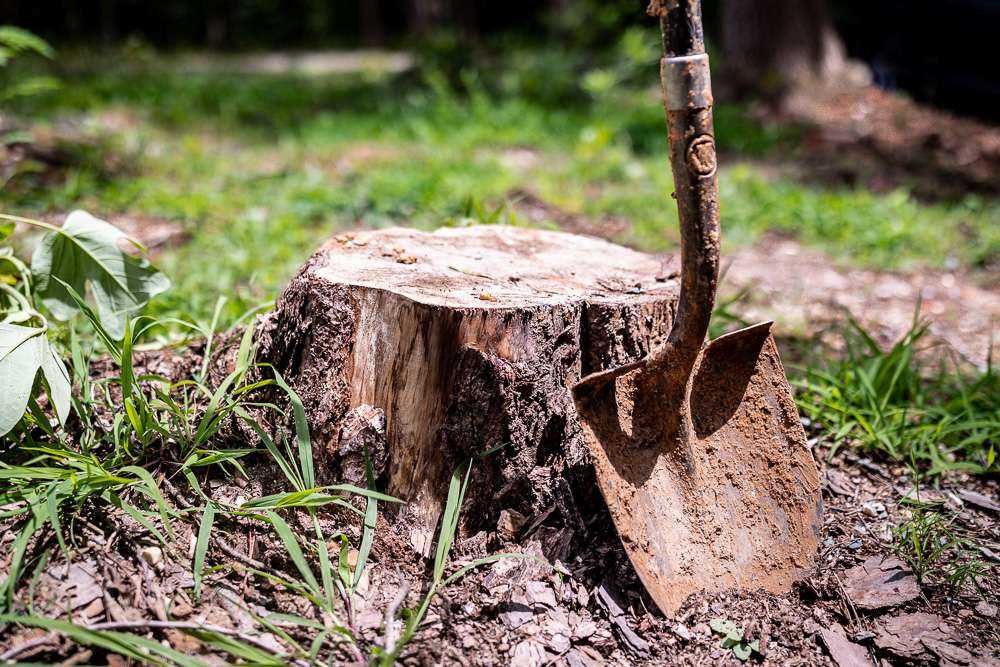
Drilling holes in a tree stump can be an effective way to prevent regrowth. By drilling holes around the perimeter of the stump and filling them with herbicide, you can kill the remaining roots and prevent new growth from sprouting. This method is often used to prevent suckering, where new shoots emerge from the stump or roots of the tree.
5. Providing Habitat
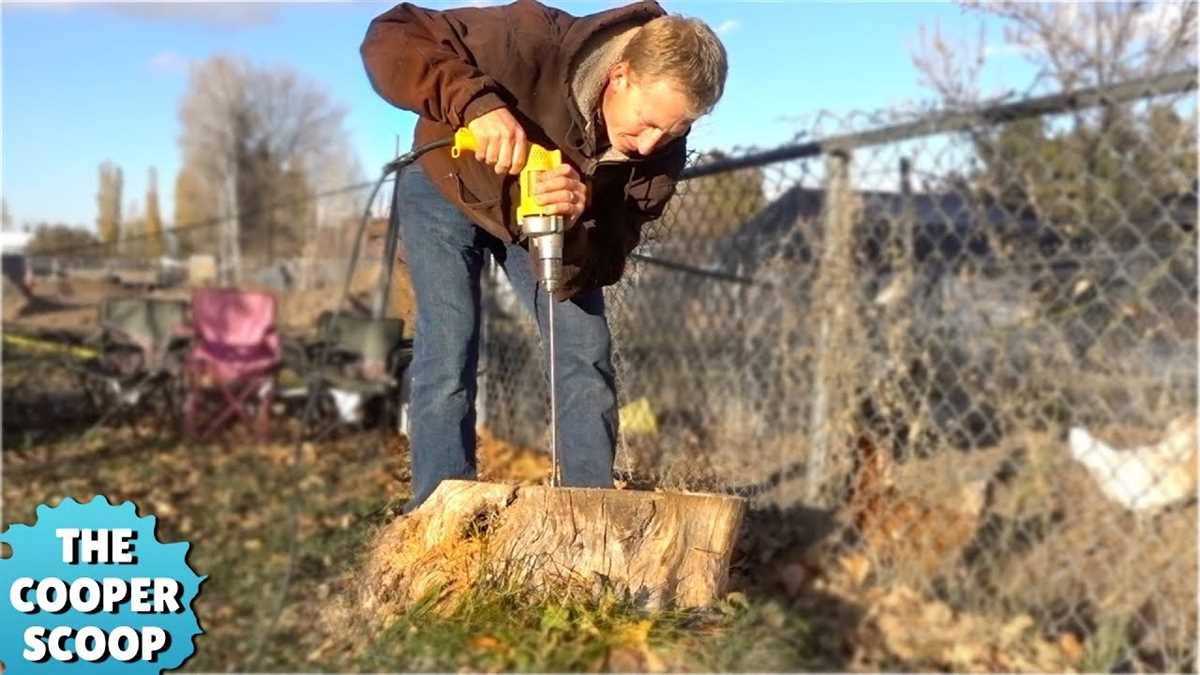
Tree stumps can provide valuable habitat for various organisms. By drilling holes into the stump, you create hiding places and nesting sites for insects, birds, and other small animals. These holes can be of different sizes and depths to accommodate a wide range of species.
Before you start drilling holes in a tree stump, make sure to consider your specific goals and the condition of the stump. It’s always a good idea to consult with an arborist or tree removal specialist to ensure you approach the process safely and effectively.
What You’ll Need for Drilling a Hole in a Tree Stump
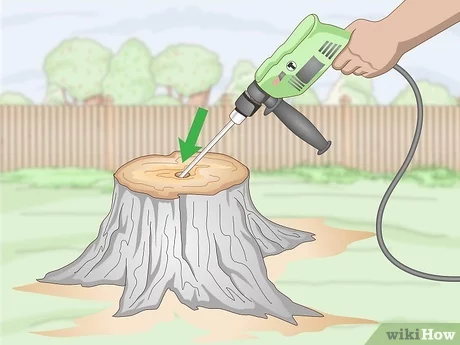
In order to successfully drill a hole in a tree stump, you’ll need to gather a few tools and materials. Here is a list of everything you’ll need:
- A drill with a spade bit or an auger bit attachment
- Safety goggles
- Gloves
- A tree stump
- A measuring tape
- A pencil or marker
- A sturdy ladder or step stool (if needed)
The most important tool for this project is, of course, the drill. You can use either a regular drill with a spade bit or an auger bit attachment, depending on the size of the hole you want to create. The spade bit is ideal for smaller holes, while the auger bit is better suited for larger holes.
It’s important to prioritize safety when drilling a hole in a tree stump, so be sure to wear safety goggles to protect your eyes from flying debris. Additionally, wearing gloves will help protect your hands while handling the tools and materials.
You will need a tree stump to drill the hole into. Make sure the stump is stable and securely positioned before you begin. Measure the stump to determine the desired location and depth of the hole, and use a pencil or marker to mark the spot.
Lastly, if the tree stump is tall and you need additional height to comfortably reach the drilling area, you may need to use a sturdy ladder or step stool. It’s important to have a stable and secure setup to ensure your safety while working.
Once you have gathered all of the necessary tools and materials, you will be ready to start drilling a hole in your tree stump.
The Tools You’ll Need
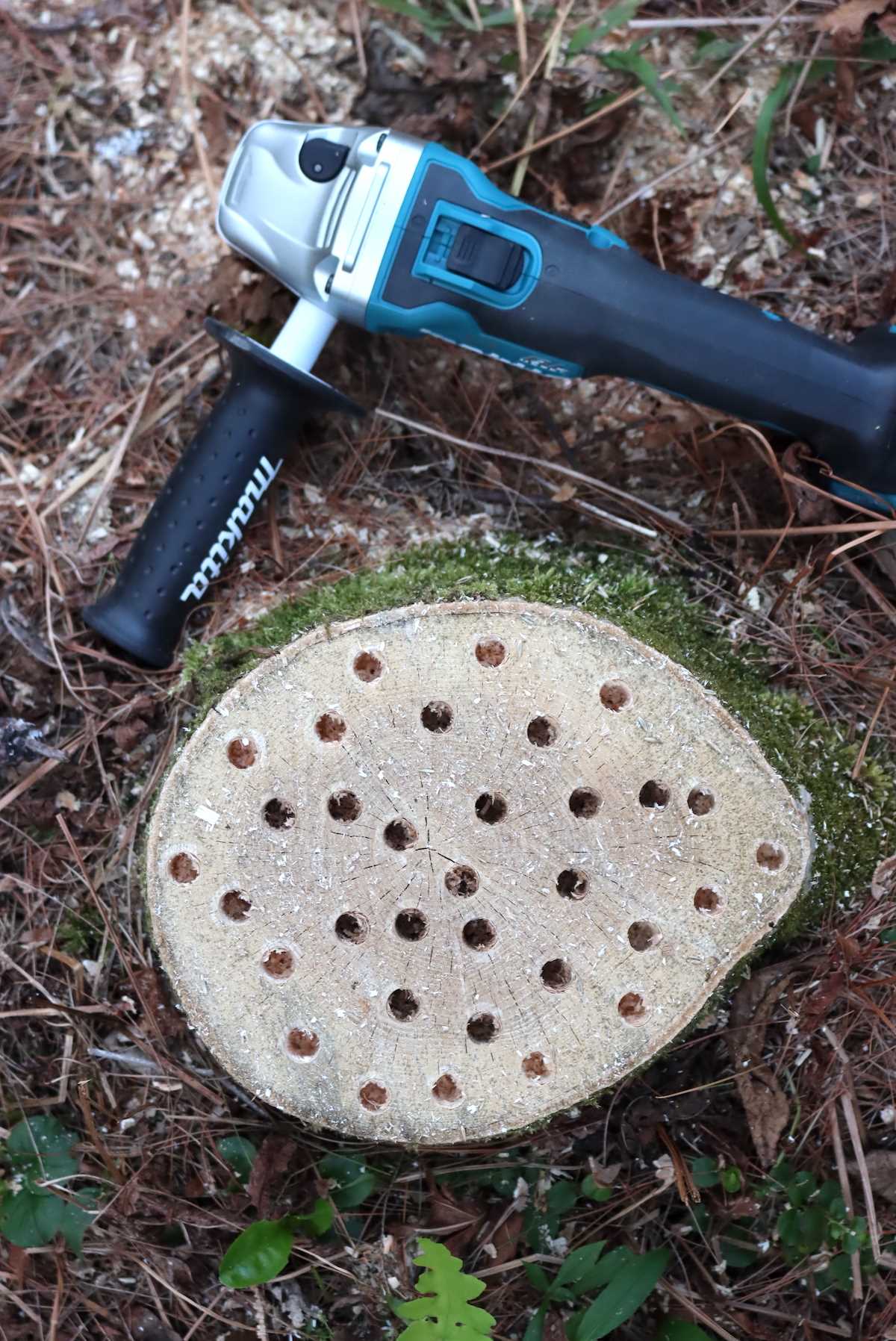
- Power Drill: A power drill with a large drill bit is necessary for drilling a hole in the tree stump. Make sure the drill is in good working condition and has enough power to handle the job.
- Extension Cord: An extension cord will be needed to reach the tree stump if it is not located near an electrical outlet. Make sure the extension cord is long enough and can handle the power requirements of the drill.
- Safety Equipment: It is important to wear appropriate safety equipment when drilling a hole in a tree stump. This includes safety glasses to protect the eyes from flying debris, gloves to protect the hands, and ear protection if the drill is loud.
- Chisel or Pry Bar: A chisel or pry bar can be helpful for removing any loose or stubborn pieces of wood that may be left in the hole after drilling.
- Debarking Tool: Depending on the condition of the tree stump, you may need a debarking tool to remove any loose or peeling bark before drilling. This will ensure a clean and smooth surface for drilling.
- Brush or Broom: After drilling the hole, you will need a brush or broom to clean away any wood chips or debris from the surface of the stump.
The Safety Gear You’ll Need
- Safety Glasses: Protect your eyes from debris, wood fragments, and any potential hazards by wearing safety glasses.
- Ear Protection: Drilling can be a noisy process, so it’s important to wear ear protection such as earplugs or earmuffs to prevent hearing damage.
- Gloves: Wear a pair of heavy-duty gloves to protect your hands from splinters, sharp edges, and any potential injuries.
- Dust Mask: A dust mask will help you avoid inhaling wood dust and other particles that may be released during the drilling process.
- Work Boots: Wear sturdy work boots with slip-resistant soles to provide proper foot protection and prevent any accidents or injuries.
It’s essential to wear the necessary safety gear to ensure your protection and minimize the risk of accidents or injuries while drilling a hole in a tree stump. Make sure that all safety gear fits properly and is in good condition before starting the drilling process.
How to Drill a Hole in a Tree Stump: A Step-by-Step Guide
Step 1: Gather the necessary tools and materials
To drill a hole in a tree stump, you will need the following:
- A power drill
- A drill bit suitable for wood
- Safety goggles
- Gloves
- Measuring tape
Step 2: Measure and mark the desired location
Use a measuring tape to determine the exact spot where you want to drill the hole. Mark the spot on the tree stump with a pen or marker.
Step 3: Put on safety gear
Before you begin drilling, put on your safety goggles and gloves to protect your eyes and hands from any potential debris or splinters.
Step 4: Drill the hole
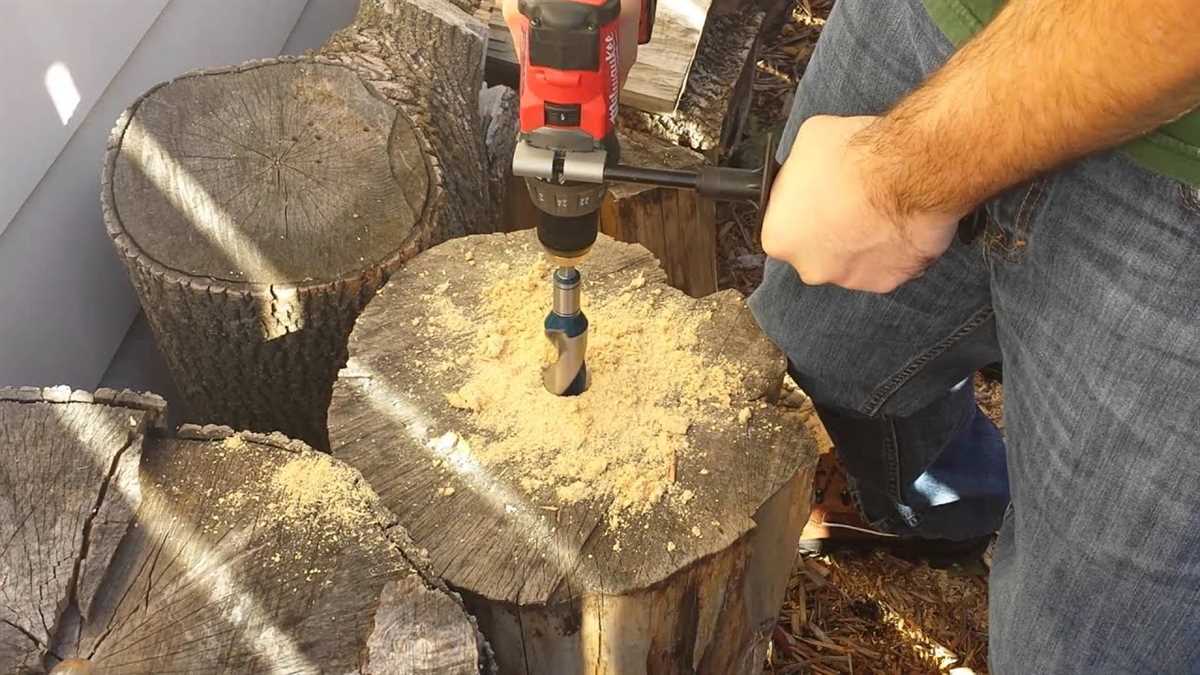
Attach the appropriate drill bit to your power drill. Start drilling slowly into the marked spot on the tree stump. Apply firm but gentle pressure as you drill, letting the drill bit do the work. Continue drilling until you reach the desired depth.
Step 5: Remove the drill bit
Once you have drilled the hole, carefully remove the drill bit from the tree stump. Be cautious as the drill bit may still be hot from friction. Set it aside in a safe place.
Step 6: Clean up the area
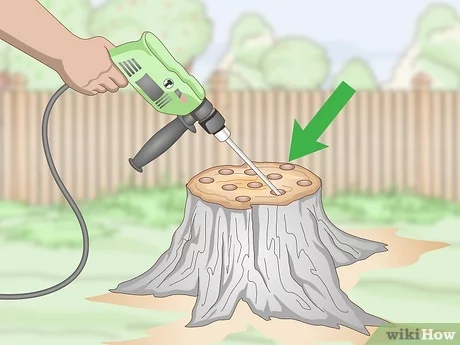
After drilling the hole, sweep away any wood shavings or debris from the area around the tree stump. Dispose of them properly.
Step 7: Optional: Fill the hole
If desired, you can fill the hole with a wood filler or epoxy to create a smoother surface. Follow the manufacturer’s instructions for the filler or epoxy you choose to use.
Step 8: Enjoy your drilled tree stump
Now that you have successfully drilled a hole in the tree stump, you can use it for various purposes such as planting flowers, placing a decorative object, or even using it as a natural bird feeder.
Remember to always exercise caution when using power tools and follow safety guidelines to prevent accidents and injuries.
Step 1: Prepare the Tree Stump
Before you begin drilling a hole in the tree stump, it’s important to prepare the stump to ensure the process goes smoothly. Follow these steps to properly prepare the tree stump:
1. Clear the Area
Remove any debris, rocks, or other objects surrounding the tree stump. This will provide you with a clear and safe work area.
2. Trim Excess Branches
If there are any branches or shoots coming out of the tree stump, trim them down using a pair of pruning shears or a saw. This will make it easier to access the stump and prevent any interference while drilling.
3. Clean the Stump Surface
Use a brush or broom to clean the surface of the tree stump. Remove any loose bark, dirt, or debris that may be present. This will ensure a clean and even surface for drilling.
4. Measure and Mark the Center
Use a tape measure to find the center of the tree stump. Mark this point with a pencil or marker. This will serve as your guide when drilling the hole.
5. Gather Safety Equipment
Before you start drilling, make sure you have the necessary safety equipment. This can include safety glasses, gloves, and ear protection. It’s important to protect yourself during the drilling process.
Step 2: Choose the Right Drill Bit
Choosing the right drill bit is essential for effectively drilling a hole in a tree stump. The type of drill bit you use will depend on the size and type of hole you want to create in the stump.
1. Consider the Size of the Hole
Before selecting a drill bit, you need to determine the size of the hole you want to drill in the tree stump. If you want a small hole for drainage or to add chemicals to the stump, a smaller-sized drill bit will be sufficient. However, for larger holes or if you plan to use the hole for other purposes like inserting a planter or a post, you will need a larger-sized drill bit.
2. Choose the Right Type of Drill Bit
There are several types of drill bits that can be used for drilling holes in tree stumps, including:
- Spade Bit: Spade bits are commonly used for drilling larger holes in wood. They have a flat, paddle-like shape with a sharp edge for efficient cutting.
- Forstner Bit: Forstner bits are designed for drilling flat-bottomed holes with clean, precise edges. They are ideal for creating holes for planting and other decorative purposes.
- Auger Bit: Auger bits are commonly used for drilling deep holes in wood. They have a spiral design that helps remove wood chips as you drill.
3. Consider the Material of the Drill Bit
Depending on the type of tree stump you are drilling into, you may need to consider the material of the drill bit. For softer wood stumps, standard high-speed steel (HSS) drill bits will work fine. However, if the stump is made of harder wood or contains nails or other obstacles, you may need to use a carbide-tipped or diamond-tipped drill bit for better durability and performance.
By considering the size of the hole, the type of drill bit, and the material of the drill bit, you can choose the right drill bit for effectively drilling a hole in your tree stump.
FAQ:
Why would someone want to drill a hole in a tree stump?
Drilling a hole in a tree stump can be done for a variety of reasons. One common reason is to speed up the decomposition process of the stump. By drilling holes, you create more surface area for beneficial organisms like fungi and bacteria to break down the wood. Additionally, drilling holes can help with stump removal by providing access points for chemical stump removers to penetrate the stump more easily.
What tools do I need to drill a hole in a tree stump?
You’ll need a few tools to drill a hole in a tree stump. The main tool you’ll need is a drill with a spade or paddle bit attachment. The size of the bit will depend on the desired diameter of the hole. You’ll also need safety glasses, work gloves, and a sturdy ladder or step stool if the stump is tall.
What is the best technique for drilling a hole in a tree stump?
The best technique for drilling a hole in a tree stump is to start by cleaning any debris from the area around the stump. This will make sure the drill bit doesn’t get clogged. Then, position your ladder or step stool securely near the stump. Put on your safety glasses and work gloves. Next, attach the spade or paddle bit to your drill and position it above the spot where you want to drill the hole. Slowly drill into the stump, applying steady pressure and keeping the drill level. Once the hole is drilled, remove the drill bit and clean up any wood shavings.
How deep should I drill the hole in the tree stump?
The depth of the hole you should drill in a tree stump depends on your goals. If you’re drilling the hole to aid in decomposition, a depth of 6 to 12 inches should be sufficient. This will allow beneficial organisms to access the wood and begin breaking it down. If you’re drilling the hole for chemical stump removal, follow the instructions on the stump remover packaging for the recommended depth.
How many holes should I drill in a tree stump?
The number of holes you should drill in a tree stump depends on its size and how quickly you want it to decompose. As a general rule, you should drill one hole for every 10 inches of stump diameter. For example, if the stump is 30 inches in diameter, you should drill three holes. However, if you’re using chemical stump remover, you may need to drill additional holes to ensure proper penetration and effectiveness.
What should I do after drilling holes in a tree stump?
After drilling holes in a tree stump, you may choose to fill the holes with a chemical stump remover to speed up the decomposition process. Follow the instructions on the stump remover packaging for the proper application. Alternatively, you can also cover the stump with a tarp or plastic sheet to retain moisture and create a dark, warm environment for decomposition. Over time, the stump will gradually break down and can be easily removed or left to naturally become part of the surrounding soil.
Video:











